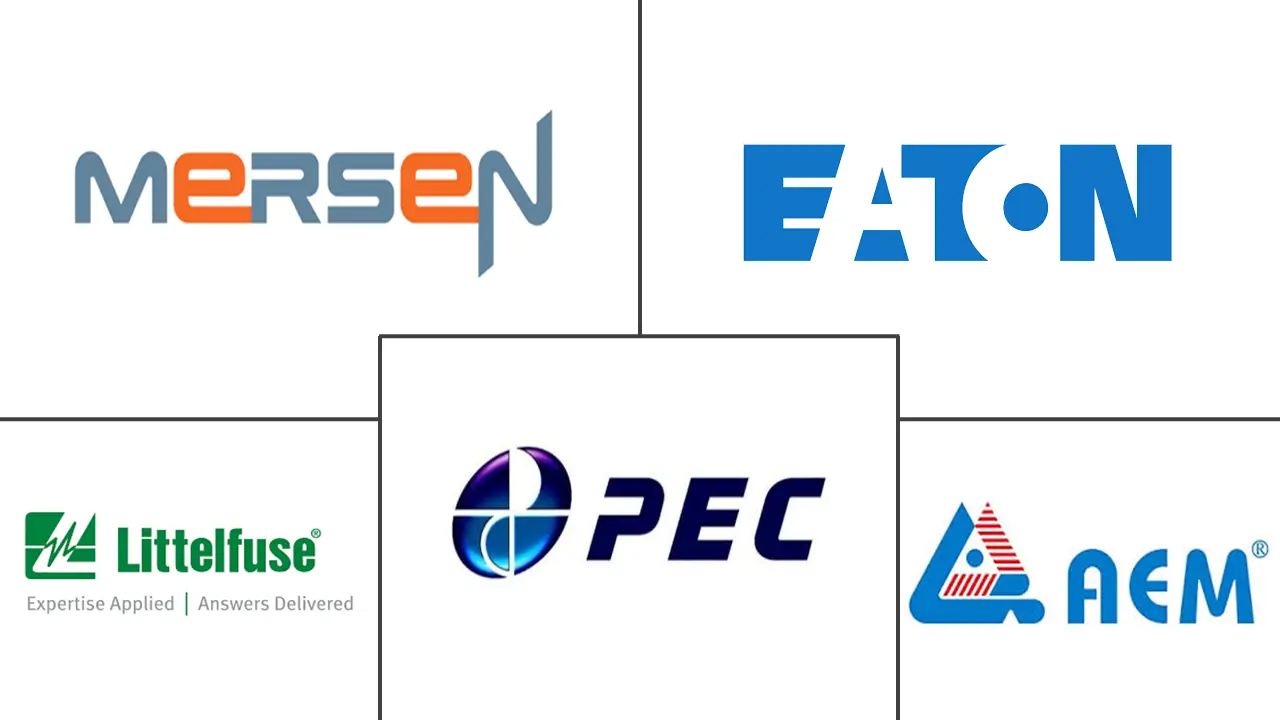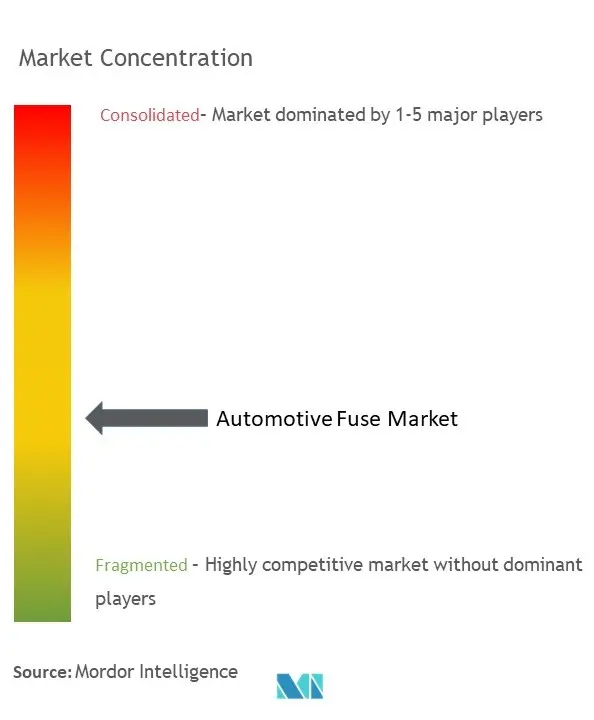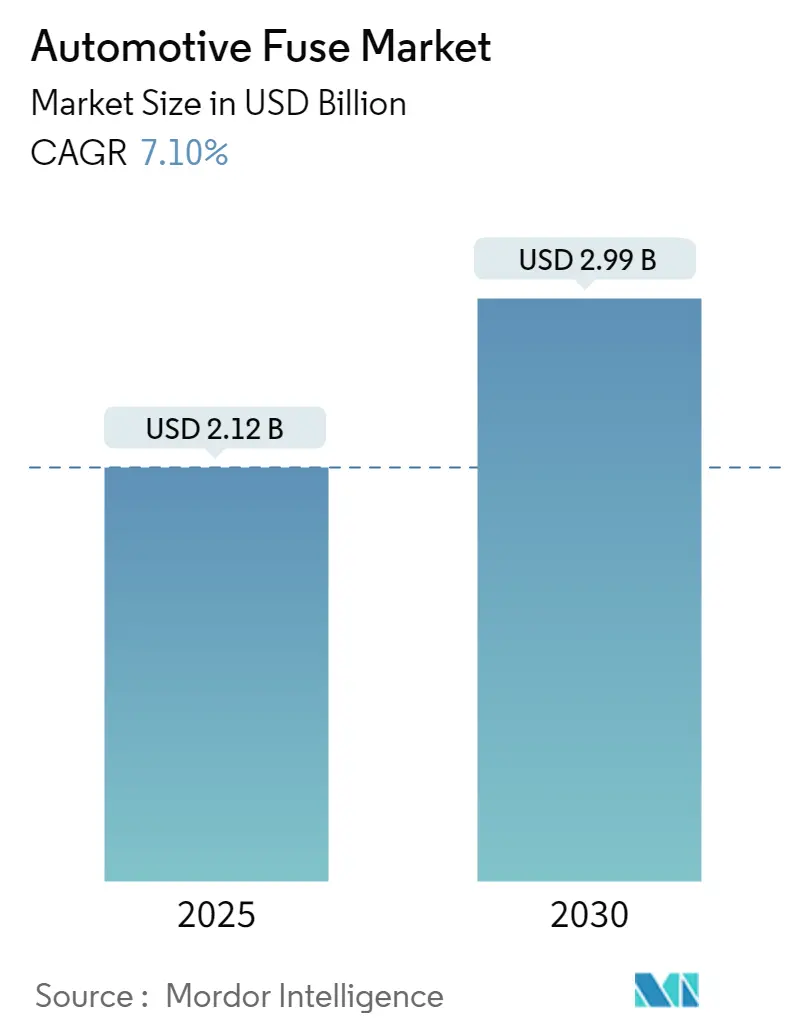
Automotive Fuse Market Analysis
The Automotive Fuse Market size is estimated at USD 2.12 billion in 2025, and is expected to reach USD 2.99 billion by 2030, at a CAGR of 7.1% during the forecast period (2025-2030).
Automotive fuses safeguard a vehicle's wiring and electrical components. Typically set at 32 volts DC, these fuses can operate at 42 volts. Housed in one or more fuse boxes, they are usually located on one side of the engine compartment or under the dashboard near the steering wheel. These fuses protect against short circuits and over-currents, disconnecting the circuit upon detecting potentially dangerous current levels.
- Automotive fuses protect electrical circuits from overcurrent and short-circuit situations. Essential for all vehicle types, from commercial trucks to passenger cars, the automotive fuse market is poised for rapid expansion in the coming years. This growth is driven by several factors: the surging popularity of electric vehicles, an increasing demand for advanced safety features, and the escalating complexity of automotive electrical systems.
- The automotive industry underwent a significant transformation with the introduction of electrification and autonomous driving technologies. This evolution is driving the demand for automotive fuses, which are critical components for ensuring the safety and reliability of modern vehicles.
- Technological advancements in the automotive industry, the rise of driverless cars, and the integration of Internet of Things (IoT) technologies further drive the demand for automotive fuses. These advancements require robust circuit protection methods to maintain the dependability and integrity of vehicle electronics. Innovations in fuse technology, particularly those catering to the needs of electric and hybrid vehicles, are expected to propel the growth of the market.
- Despite modern vehicles' growing complexity and electrical demands, advancements in low-voltage fuse technology have lagged. Modern vehicles incorporate numerous electronic systems, such as advanced driver-assistance systems (ADAS), infotainment systems, and electric powertrains, which require robust and reliable fuses. However, this technological gap limits the fuses' ability to cater to the evolving requirements of today's automotive electrical systems.
- The anticipated growth in automotive production is projected to decelerate in 2024 due to a decline in demand, especially within advanced economies. The ongoing high interest rates are exerting pressure on both automotive production and sales as household incomes continue to be strained and financing options have become increasingly expensive. Furthermore, as existing order backlogs are fulfilled, a reduction in demand for automotive production is expected in 2024 and 2025. The sector faces significant downside risks, including persistent inflation and potential component shortages that may disrupt automotive supply chains.
Automotive Fuse Market Trends
Electric/Hybrid Vehicles to Witness Major Growth
- Battery electric vehicles (BEVs), commonly known as all-electric vehicles, utilize an electric motor instead of a traditional internal combustion engine. In contrast, hybrid electric vehicles combine an internal combustion engine with one or more electric motors, drawing energy from stored batteries. Unlike BEVs, hybrid electric vehicles cannot be plugged in for charging; their batteries recharge through regenerative braking and the internal combustion engine. This electric motor's added power can enable a smaller engine, and the battery can also support auxiliary loads, minimizing engine idling when the vehicle is stationary.
- Fuses in Electric Vehicles (EVs) and Hybrid Electric Vehicles (HEVs) safeguard electrical circuits, equipment, and batteries from faults like overloads and short circuits. EVs operate their electrical circuits using direct current (DC) voltage.
- As charging times decrease, a growing demand for systems supporting higher voltage and current is growing. Transitioning from 400V to 800V introduces significant challenges for battery circuit protection. While the push for quicker charging times necessitates elevated system voltages, an extended driving range increases fault currents. The diverse range of planned EVs amplifies the demand for higher operating currents. These dynamics are reshaping circuit protection needs.
- Electric cars are making significant inroads in global markets: in China, over one in three new car registrations were electric; in Europe, the figure surpassed one in five; and in the United States, it reached one in ten. Conversely, electric car sales remain subdued even in advanced automotive markets like Japan and India. This concentration in sales shapes the global electric car stock and underscores the significance of trends in China, which accounts for about two-thirds of total car sales and stocks.
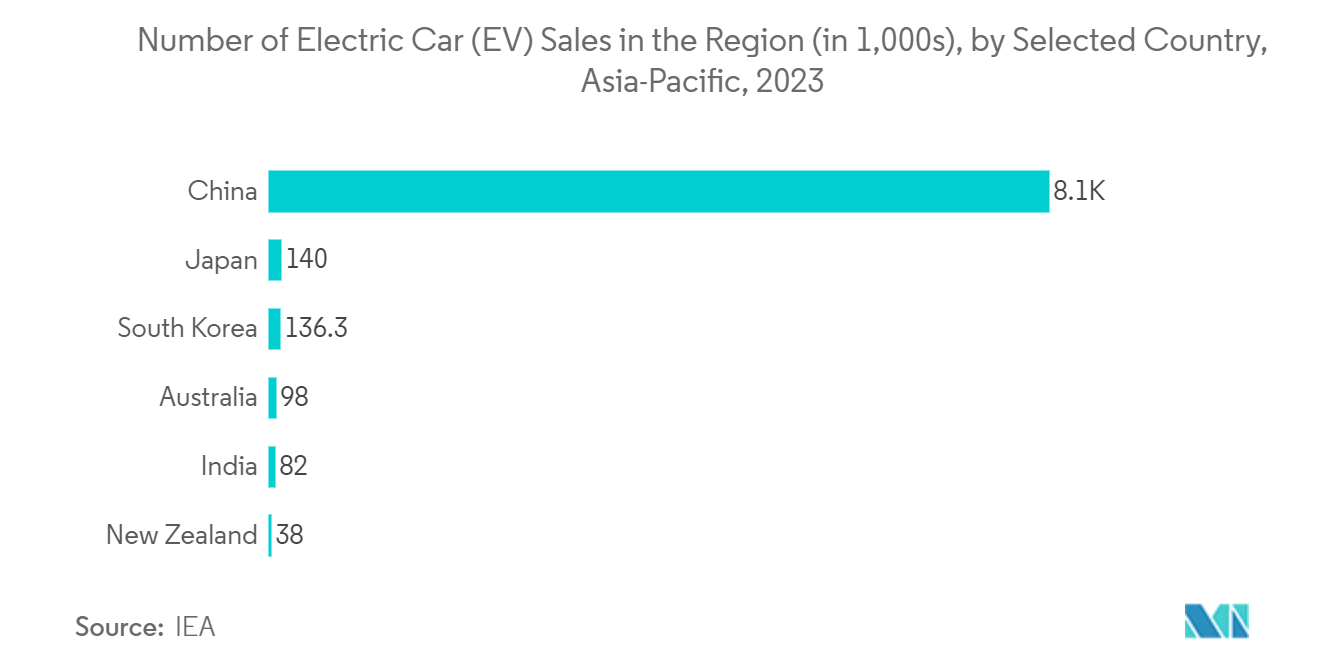
Asia Pacific to Register Major Growth
- China is a global leader in the automotive and mobility industry, driven by its strong domestic market and immense potential. The Chinese Ministry of Industry and Information Technology predicts domestic vehicle production is expected to reach 35 million by 2025, reinforcing China's position as the world's leading car manufacturer. This growth propels rapid advancements across various sectors of China's automobile industry.
- As reported by the International Trade Administration, Japan ranks as the world's fourth-largest automotive market, trailing only China, the United States, and India. Japan is a global powerhouse in automotive manufacturing, hosting major automakers like Toyota, Honda, Nissan, Mazda, and Suzuki. The automotive sector constitutes 2.9% of Japan's GDP, underscoring its economic significance. Consequently, Japan enforces stringent laws focused on vehicle safety and pollution control.
- Japan is championing international standards for testing cycles that gauge fuel consumption, CO2, and other emissions. Notably, Japan played a pivotal role in developing the World Harmonized Light Vehicle Test Cycle (WLTC) under the UN's World Forum for Harmonization of Vehicle Regulations. Reflecting this commitment, Japan is transitioning from its JC08 test cycle to the WLTC for passenger and non-heavy-duty vehicles.
- The automotive industry is crucial to economic growth and job creation, contributing 7.1% to India's GDP. The growing consumer demand, rising income, urbanization, and changing consumer behavior are the major driving forces for the automotive industry’s growth.
- In April 2024 alone, production figures for passenger vehicles, three-wheelers, two-wheelers, and quadricycles reached 2,358,041 units. Additionally, in FY23, total automobile exports from India amounted to 4,761,487 vehicles. Over the years, the sector's contribution to the national GDP has significantly increased to 7.1%. Moreover, the automotive sector provides direct and indirect employment to approximately 19 million individuals.
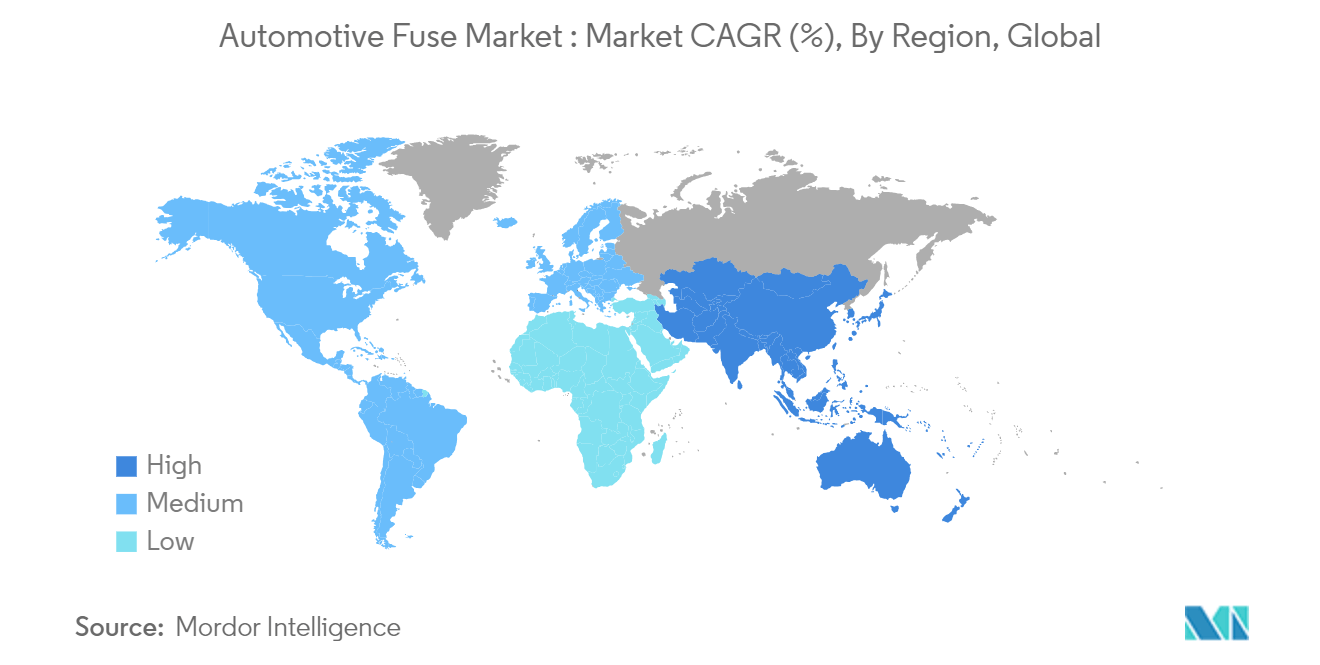
Automotive Fuse Industry Overview
The automotive fuse market is semiconsolidated due to the large number of local manufacturers available in the automotive fuse market landscape. The significant players in the market include Pacific Engineering Corporation, Littelfuse Inc., Eaton Corporation, Mersen Electrical Power, and AEM Components (USA) Inc.
The market studied is fluctuating due to growing consolidation, technological advancement, and geopolitical scenarios. In addition, with the increasing number of new SMEs, the intense competition in the market studied is expected to continue to rise, considering their ability to invest, which results from their revenues.
Further, in a market where the sustainable competitive advantage through innovation is considerably high, competition is anticipated to grow, considering the projected increase in demand from new customers across various end-user industries. In such a situation, the brand identity plays a major role, considering the importance of quality that the end-users expect from a fuse manufacturing player. The market penetration levels are also high with large market incumbents, such as Eaton Corporation, Little Fuse Inc., Pacific Engineering Corporation, Mersen Electric Power, and AEM Components USA Inc.
Automotive Fuse Market Leaders
-
Pacific Engineering Corporation
-
Littelfuse Inc.
-
Eaton Corporation
-
Mersen Electrical Power
-
AEM Components (USA) Inc.
- *Disclaimer: Major Players sorted in no particular order
Automotive Fuse Market News
- June 2024: SOC Corporation announced introducing a series of products that meet the AEC-Q200 Rev E qualification, having successfully undergone the reliability stress tests specified in the standard. These fuses are extensively utilized in circuits for applications such as DC/DC converters, onboard chargers (OBC), air conditioning compressors, battery management systems (BMS), and GPS navigation systems.
- May 2024: Eaton introduced a range of fuses specifically designed for commercial electrified vehicles (EVs). The Bussmann series fuses from Eaton can manage currents up to 1,400 amps and up to 900 volts, with the option for customization according to client requirements. Eaton would enhance current capacity through design alterations or by connecting several fuses in parallel.
Automotive Fuse Industry Segmentation
Automotive fuses safeguard a vehicle's wiring and electrical components. Typically set at 32 volts DC, these fuses can also operate at 42 volts. Housed in one or more fuse boxes, they are usually located on one side of the engine compartment or under the dashboard near the steering wheel. These fuses protect against short circuits and overcurrents, disconnecting the circuit upon detecting potentially dangerous current levels. The study monitors the revenue generated by the global sales of automotive fuse markets.
The automotive fuse market is segmented by type (blade, glass, slow blow, high-voltage fuses, chip fuse, other types), type of vehicle (passenger cars ((traditional-ICE)), commercial vehicles ((traditional-ICE)), electric/hybrid vehicles), and geography (North America [United States and Canada], Europe [Spain, Germany, and France, rest of Europe], Asia-Pacific [China, India, Japan, rest of Asia-Pacific], Latin America, and Middle East and Africa). The market sizes and forecasts are provided in terms of value (USD) for all the above segments.
| By Type | Blade | ||
| Glass | |||
| Slow Blow | |||
| High-Voltage Fuses | |||
| Chip Fuse | |||
| Other Types | |||
| By Type of Vehicle | Passenger Cars (Traditional -ICE) | ||
| Commercial Vehicles (Traditional -ICE) | |||
| Electric/Hybrid Vehicles | |||
| By Geography*** | North America | United States | |
| Canada | |||
| Europe | France | ||
| Germany | |||
| Spain | |||
| Asia | China | ||
| Japan | |||
| India | |||
| Australia and New Zealand | |||
| Latin America | |||
| Middle East and Africa | |||
Automotive Fuse Market Research Faqs
How big is the Automotive Fuse Market?
The Automotive Fuse Market size is expected to reach USD 2.12 billion in 2025 and grow at a CAGR of 7.10% to reach USD 2.99 billion by 2030.
What is the current Automotive Fuse Market size?
In 2025, the Automotive Fuse Market size is expected to reach USD 2.12 billion.
Who are the key players in Automotive Fuse Market?
Pacific Engineering Corporation, Littelfuse Inc., Eaton Corporation, Mersen Electrical Power and AEM Components (USA) Inc. are the major companies operating in the Automotive Fuse Market.
Which is the fastest growing region in Automotive Fuse Market?
Asia Pacific is estimated to grow at the highest CAGR over the forecast period (2025-2030).
Which region has the biggest share in Automotive Fuse Market?
In 2025, the Asia Pacific accounts for the largest market share in Automotive Fuse Market.
What years does this Automotive Fuse Market cover, and what was the market size in 2024?
In 2024, the Automotive Fuse Market size was estimated at USD 1.97 billion. The report covers the Automotive Fuse Market historical market size for years: 2019, 2020, 2021, 2022, 2023 and 2024. The report also forecasts the Automotive Fuse Market size for years: 2025, 2026, 2027, 2028, 2029 and 2030.
Our Best Selling Reports
Automotive Fuse Industry Report
Statistics for the 2025 Automotive Fuse market share, size and revenue growth rate, created by Mordor Intelligence™ Industry Reports. Automotive Fuse analysis includes a market forecast outlook for 2025 to 2030 and historical overview. Get a sample of this industry analysis as a free report PDF download.

